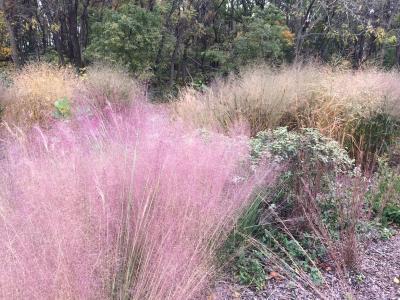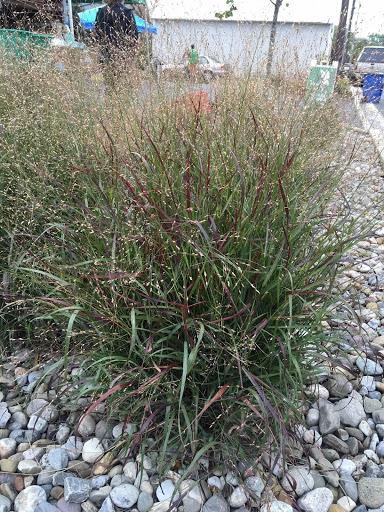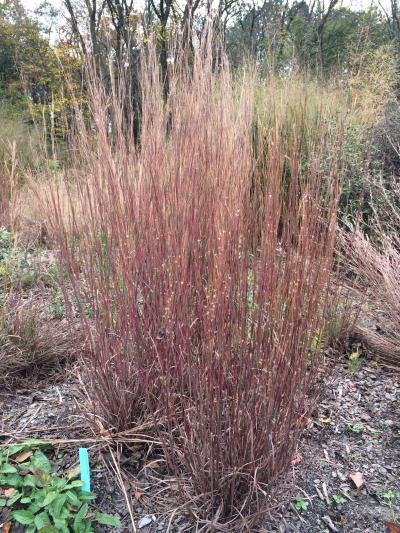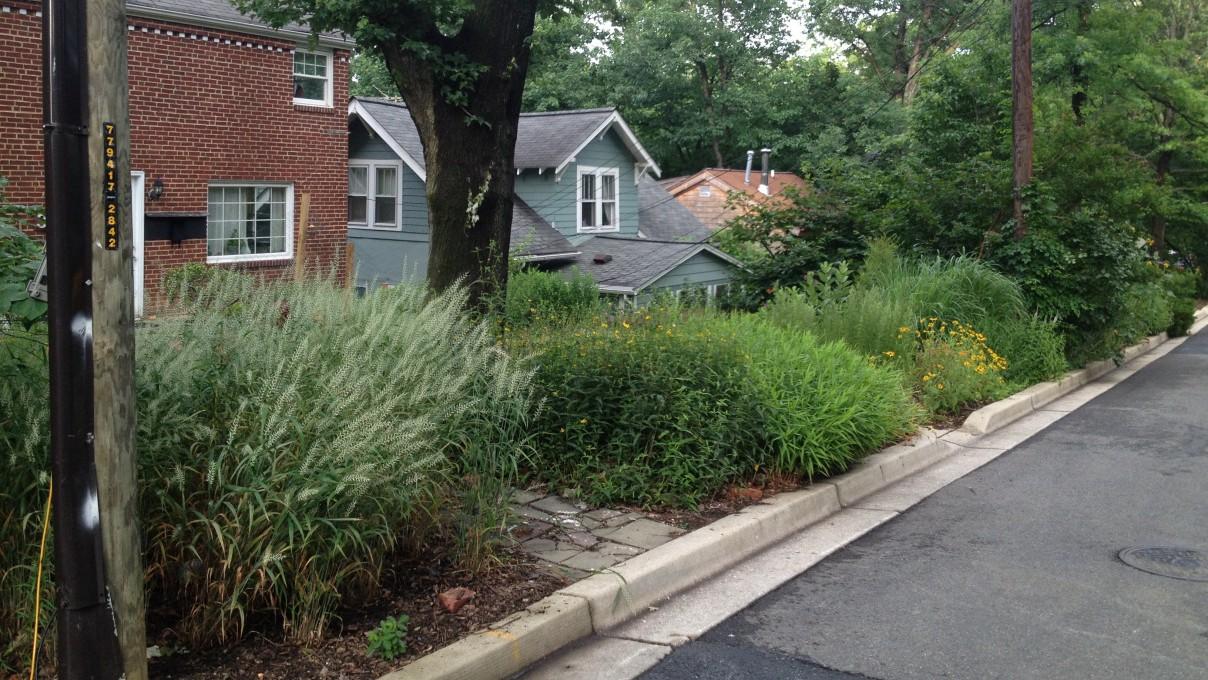“Native” versus “ornamental” grasses
The term ‘native’ refers to a plant species that occurs naturally in an ecoregion and habitat over the course of evolutionary time. Because they originated in a particular ecoregion, these species are adapted to growing conditions and have co-evolved with other native species. To learn more about native plants, please refer to the page, What is a Native Plant?
‘Ornamental’ is a term used to describe plants that are propagated and grown primarily for aesthetic, rather than functional qualities. The term is typically used to describe plants that do not occur naturally in an ecoregion.
There are also many cultivars (cultivated varieties) of each species grown by the nursery industry. Cultivars of both native and ornamental grass species are available in the majority of plant nurseries.

Ornamental pink muhly grass (left) with switchgrass in the background. Photo: Mikaela Boley
Recommended ornamental grass species for Maryland landscapes
*=Native to Maryland
+=Readily self-seeds
*Big bluestem - Andropogon gerardii
One of the tallest native grasses in Maryland, from 5-8 ft. tall, this grass has a wide native range across the U.S. Leaves green to blue-green in summer, turning orange to copper red in fall with an inflorescence that looks similar to a turkey’s foot. Adaptable to a variety of soils; best used as habitat or conservation restoration as they are quite tall for the home landscape.
Blue fescue - Festuca glauca
A short, clump-forming grass with attractive blue color. The leaf blade has a very fine texture. Great to use as a groundcover or along walkways. Drought tolerant.
Common cultivars: ‘Elijah Blue’, ‘Blue Whiskers’, ‘Beyond Blue’
Foerster’s Feather Reed Grass - Calamogrostis x acutiflora ‘Karl Foerster’
A widely used ornamental grass with tall (3-5 ft.), upright habit. Showy golden seed head with feathery appearance. Will grow in a variety of soil conditions and types.

Switchgrass (Panicum virgatum) 'Shenandoah'. Photo: Mikaela Boley
*+Switchgrass - Panicum virgatum
A large native grass reaching 3-6 ft. tall (depending on cultivar). Easily grown in most soils; has wide tolerance for dry, moist, sandy or clay soils. Also has some salt tolerance, which makes it useful for the coastal plain. Good for erosion control, but does not tolerate much shade.
Common cultivars: ‘Northwind’, ‘Shenandoah’, ‘Heavy Metal’
*Prairie Dropseed - Sporobolus heterolopsis
Native grass that tolerates a variety of soil types, from heavy clay to dry, rocky soil. With a height of 2-3 ft. tall, and airy panicles of golden seed head, it serves as a great groundcover. Effective when planted en masse or along borders.

Little bluestem (Schizachyrium scoparium) 'Standing Ovation.' Photo: Mikaela Boley
*Little bluestem - Schizachyrium scoparium
A native grass with many cultivars available to exhibit the beautiful blue coloring (turning to red and orange in the fall). Grows 1.5-3 ft. tall, preferring dry soil types. Important to birds and insects, but also deer proof.
Common cultivars: ‘Standing Ovation’, ‘Cimmaron’, ‘Smoke Signal’
*Purple love grass - Eragrostis spectabilis
A very short (1-2 ft.) grass with airy clouds of purple seed head. Prefers medium to dry soil moisture and is tolerant of infertile, droughty soils. Excellent when used along borders or in mass plantings.
*+Northern sea oats - Chasmanthium latifolium
Grows in average to wet soils and is one of the more shade-tolerant grasses. Grows 2-5 ft. tall, it produces large ornamental seed heads that turn from green to bronze in the fall. Self-seeds and may spread aggressively.
*Tufted hair grass - Deschampsia cespitosa
One of the more shade-tolerant grass species, prefers part-shade over full sun. Foliage remains semi-evergreen and forms a dense tussock of thin leaf blades. Height of 2-3’, works best massed in woodland gardens or naturalized areas.
Pearl millet - Cenchrus americanus
Annual grass most commonly used in the fall for container or temporary harvest décor. May be dried and used in arrangements. This is a non-native grass that rarely escapes cultivation.
Common cultivars: ‘Purple Majesty’, ‘Purple Baron’
*+Indiangrass - Sorghastrum nutans
A tall clumping grass often planted in a seed mix with conservation or right-of-way landscapes. Takes several years to reach a mature height of 6-8 ft. Requires full sun. Foliage can take on a steely blue-green appearance, with a feathery yellow-orange seed head. May be considered too tall for the landscape. Can demonstrate dominant habit in a meadow, out-competing other species.
Common cultivars: ‘Indian Steel’, ‘Sioux Blue’
*Bottlebrush grass - Elymus hystrix
Clump-forming cool season grass with good tolerance for shade. Prefers part-shade in well-drained soils, but has adaptability to dry and clay soil types. Height of 2.5-3 ft. Attractive bristly seed heads that are 9-10 in. in length, matures earlier than warm-season grasses.
Avoid these invasive grass species
While some native grass species self-seed freely, non-native grass species that spread too easily are considered invasive to our ecosystem. It is recommended that you avoid purchasing the following ornamental species, even though plant nurseries commonly have them available.
-
Chinese silvergrass - Miscanthus sinensis and its cultivars such as ‘Zebrinus’, 'Adagio', 'Gracillimus', 'Strictus', and 'Zebrinus'
-
Chinese fountaingrass or black fountaingrass - Cenchrus purpurascens (formerly Pennisetum alopecuroides) and its cultivars such as 'Cassian', 'Hamleln', 'Little Bunny', 'Foxtrot', and 'Red Head'
-
Hardy pampas grass (also called ravenna grass or plume grass) - Tripidium ravennae
-
Japanese bloodgrass - Imperata cylindrica and the cultivar 'Red Baron'
Recommended grasses
| Common Name | Botanical Name | Height | Full Sun (FS)/Part Shade (PS) / Shade | Native To Maryland?* | Attributes |
|---|---|---|---|---|---|
|
Big bluestem |
Andropogon gerardii |
5-8' |
FS, PS |
Yes/ M, P |
Large grass; "turkey foot" seed head |
|
Blue fescue |
Festuca glauca |
6-10" |
FS |
No |
Short grass; blue color |
|
Foerster's Feather Reed Grass |
Calamogrostis x acutiflora |
3-5' |
FS |
No |
Upright habit; feathery plumes |
|
Switchgrass |
Panicum virgatum |
3-6' |
FS, PS |
Yes/ M, P, C |
Large native grass for erosion control |
|
Prairie dropseed |
Sporobolus heterolopsis |
2-3' |
FS |
Yes |
Airy clouds of seed head |
|
Little bluestem |
Schizachyrium scoparium |
1.5-3' |
FS |
Yes/ M, P, C |
Steely blue color in summer, red-orange color in fall |
|
Purple love grass |
Eragrostis spectabilis |
1-2' |
FS |
Yes |
Low grass with airy clouds of purple seed |
|
Northern sea oats |
Chasmanthium latifolium |
2-5' |
FS, PS |
Yes/ M, P, C |
Large ornamental seed heads; spreads aggressively |
|
Pink muhly grass |
Muhlenbergia capillaris |
2-3' |
FS, PS |
Yes- rare |
Clouds of pink seed head |
|
Tufted hair grass |
Deschampsia cespitosa |
2-3' |
PS |
Yes |
Shade and drought tolerant; woodland gardens |
|
Pearl millet |
Pennisetum glaucum |
4-5' |
FS, PS |
No |
Attractive purple foliage and large seed head |
|
Indiangrass |
Sorghastrum nutans |
6-8' |
FS |
Yes/ M, P, C |
Tall, upright habit; yellow-orange plumes in fall |
|
Bottlebrush grass |
Elymus hystrix |
2.5-3' |
FS, PS, Shade |
Yes/ M, P, C |
Bottle brush shaped seed heads |
* M=Mountain, P=Piedmont, C=Coast (Learn what region you are in: http://www.nativeplantcenter.net/glossary/)
Additional resources
(PDF) Native Plants for Wildlife Habitat and Conservation Landscaping, U.S. Fish & Wildlife Service
Plants Database, USDA Natural Resources Conservation Service
The Color Encyclopedia of Ornamental Grasses, by Rick Darke
Field Guide to Grasses of the Mid-Atlantic, by Sarah Chamberlain
Native Ferns, Moss, & Grasses, by William Cullina
The Cultivar Question, Maryland Department of Natural Resources
Author: Mikaela Boley, Senior Agent Associate in Home Horticulture, University of Maryland Extension, 2/2020. Rev. 2023
Still have a question? Contact us at Ask Extension.
